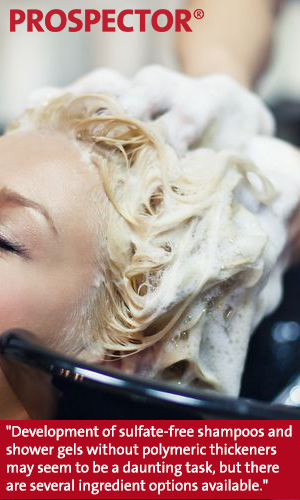 It is widely known within the community of cosmetic
It is widely known within the community of cosmetic
chemists that there are particular challenges when formulating products that must meet certain ‘free-of’ requirements. ‘Sulfate-free’ (EU) is no exception. While there are several classes of surfactants (EU) that are suitable replacements for sulfated products, the challenge usually occurs when an attempt is made to increase the viscosity of a sulfate-free system. This becomes even more difficult when the requirement is to maintain clarity and achieve viscosity targets without the use of polymeric thickeners (EU).
If the use of natural polymers is allowed, then the palette of available ingredients would broaden to include gums such as Xanthan gum (EU). However, if the brief is more restrictive, this is a tall order indeed! While such requirements would negate traditional and popular approaches such as the use of carbomers (EU), cellulose derivatives (EU) or highly ethoxylated materials like PEG-150 Distearate (EU), there are other avenues that are available to the formulator.
Those skilled in the art might naturally first resort to Sodium Chloride (EU) as a thickening agent – which is a cost effective approach that may deliver the desired results, depending on the salt sensitivity of the surfactant system involved. The limits for salt tolerance can easily be established by creating a salt curve with the salt contribution from surfactants included in the overall totals. Furthermore, product performance and aesthetics should also be evaluated to determine whether the rheological profile is being negatively affected to the extent that it results in stringiness.
In addition to the primary surfactants selected, the role of secondary surfactants in building viscosity should not be underestimated. Betaines (EU), Hydroxysultaines (EU), Alkanolamides (EU) and Amine Oxides (EU) are but a few of the chemical classes that have multifunctional benefits, including viscosity enhancement. Given the current status of mono- and diethanolamines, mono- and diisopropanolamines have proven to be effective substitutes as foam boosters (EU) and viscosifiers. These chemical classes are well represented among products listed on ULProspector.com. These types of ingredients, in conjunction with Sodium Chloride, may also benefit non-ionic systems, which can be stubbornly non-responsive to salt.
Surfactant ratios also play a significant role is maximizing viscosity and should be thoroughly investigated. Understandably, given aggressive timelines, time is not always a luxury that the formulator can afford. Employing an experimental design as a tool to identify optimal ratios should be a consideration whenever possible. Similarly, the order in which surfactants are added can also impact viscosity and should be investigated as well as the system’s response to pH adjustment.
While development of clear sulfate-free shampoos and shower gels without polymeric thickeners may at first seem to be a daunting task, be assured that there are several formulation and ingredient options available that would allow you to demonstrate your creative talents.
The views, opinions and technical analyses presented here are those of the author or advertiser, and are not necessarily those of ULProspector.com or UL Solutions. The appearance of this content in the UL Prospector Knowledge Center does not constitute an endorsement by UL Solutions or its affiliates.
All content is subject to copyright and may not be reproduced without prior authorization from UL Solutions or the content author.
The content has been made available for informational and educational purposes only. While the editors of this site may verify the accuracy of its content from time to time, we assume no responsibility for errors made by the author, editorial staff or any other contributor.
UL Solutions does not make any representations or warranties with respect to the accuracy, applicability, fitness or completeness of the content. UL Solutions does not warrant the performance, effectiveness or applicability of sites listed or linked to in any content.



What type of Product Formulations are you seeking assistance with?
For clear sulfate free systems, the ISELUX technology from Innsospec is a great option, as well as performance blends such as the Iselux SFS and Iselux Ultra Mild, which are cold process compatible and easily thickened with a wide viscosity range. Innospec offers great insight and support in formulating with these technologies with superb application support and demonstration samples. Definitely worth checking out!
Thank you Ms Taylor – Nice starting discussion you have left us thirsting for more. – President National Society of Cosmetic Chemists
Excellent article Priscilla.
What primary surfactants would you suggest to increase the viscosity of a sulfate-free system when the requirement is to maintain clarity in the final formulation?
please i need a suitable formula for a sulphate free shampoo with Crodasinic LS30 and Carbopol Utrez 21 as viscosity builder with high clarity. i appreciate.